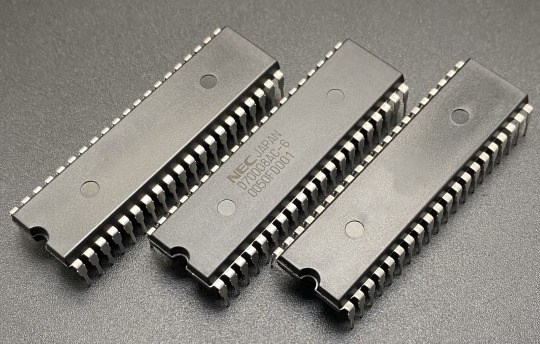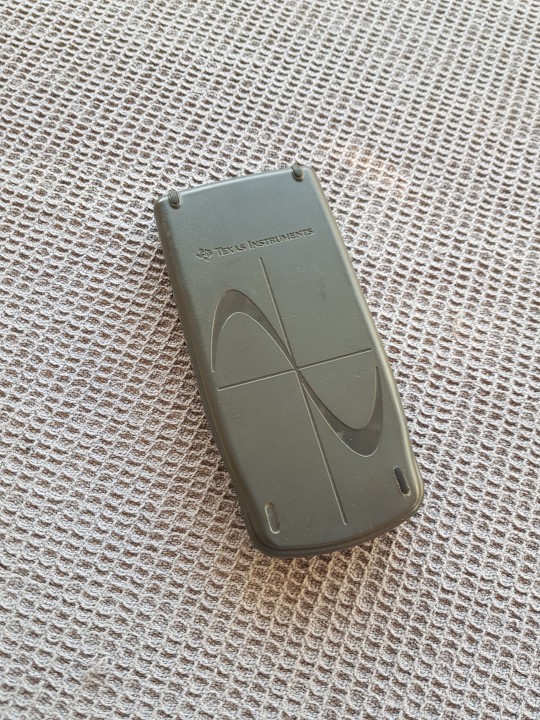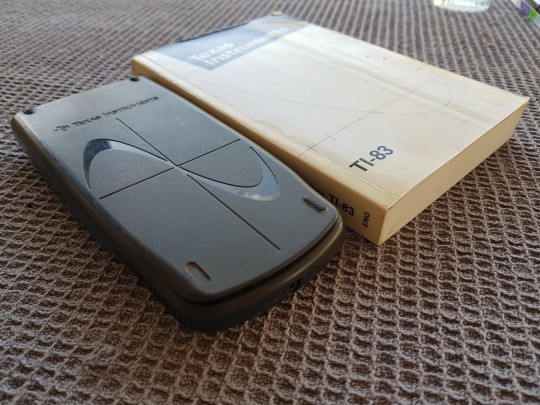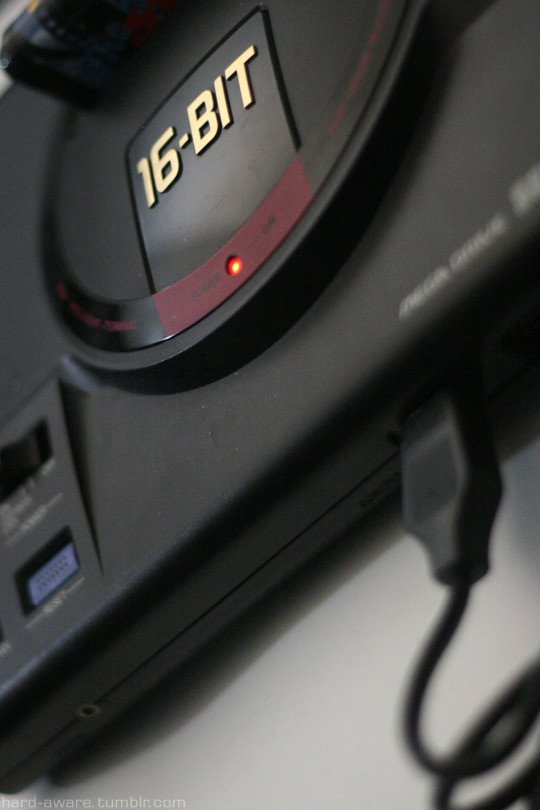#Zilog
Explore tagged Tumblr posts
Text

Sony HitBit HB-101 (1984)
The HB-101 is part of the MSX standard, a unified home computer architecture developed by Microsoft and ASCII Corporation.
- CPU: Zilog Z80, running at 3.58 MHz
- RAM: 64 KB
- Video: Video Display Processor (VDP) with a maximum resolution of 256 x 192 pixels, supporting up to 16 colors
- Sound: Programmable Sound Generator (PSG) for audio
#sony#sony corporation#hitbit#retro computers#1980s#80s#design#msx#retrocomputing#retrocomputer#retro tech#zilog#home computer
742 notes
·
View notes
Text

Various Z80 CPUs pulled from devices in my workshop.
32 notes
·
View notes
Note
I guess we both like good ol' ALU registers (A, HL)
🤝
Cast your votes here and here
4 notes
·
View notes
Text

Ladies and gentlemen...
Today, we gather not to mourn, but to celebrate the remarkable journey of an iconic piece of technology—the Zilog Z80 microprocessor. As we mark the official retirement of the Z80, we reflect on its enduring legacy that began over four decades ago.
The Z80 was more than just a collection of circuits; it was the cornerstone of a technological revolution. Introduced in 1976 by Zilog, founded by Federico Faggin and Ralph Ungermann, the Z80 quickly became a beloved figure in the world of computing. Its design was a masterpiece of innovation, combining power with versatility, and it set a new standard for microprocessors.
In its heyday, the Z80 found its way into some of the most seminal computing systems of the time. It was the brain behind pioneering personal computers like the Osborne 1 and the TRS-80. It powered the Sinclair ZX Spectrum, which introduced countless individuals to the joy of programming and gaming. Moreover, it was crucial in the development of embedded systems and influenced the arcade games that many of us cherished in our youth.
The Z80 was also a tool of education. For many young programmers and engineers, it was their first introduction to the intricacies of machine code and assembly language. It demystified the inner workings of computers, making the digital world more accessible and less daunting.
But beyond its technical achievements, the Z80's real triumph was in its ability to inspire. It sparked a generation of innovators and tinkerers, many of whom have gone on to shape the modern technological landscape. Its influence can be seen in the software we use, the games we play, and the smartphones that are now an integral part of our daily lives.
As we say goodbye to the Z80, we also say thank you. Thank you for your contributions to computing, for democratizing technology, and for inspiring creativity and innovation. Your circuits may have ceased production, but your impact will resonate for generations to come.
So, here's to the Zilog Z80—may your legacy continue to teach and inspire as long as there are stories to be told about the silicon that changed the world. Rest well, old friend, your work here is done, but your journey through the annals of technology history is eternal.
2 notes
·
View notes
Text
Z80-RIO
Z80-RIO (Z80 Operating System with Relocatable Modules and I/O Management) - a general-purpose operating system developed by Zilog in the late 1970s https://archiveos.org/z80-rio/
0 notes
Text
Un día como hoy (1 de diciembre) en la computación

El 1 de diciembre de 1941 nace Federico Faggin, doctor en física italiano, coinventor del microprocesador, llamado Proyecto 4004 que le abrió las puertas de Intel en 1970. En 1974 fundó Zilog, Inc. Donde produjo un nuevo diseño de chips para la recién nacida industria computacional #retrocomputingmx #FedericoFaggin #intel #zilog
1 note
·
View note
Text
https://www.futureelectronics.com/p/semiconductors--microcontrollers--8-bit/ez80f91az050ek-zilog-8131964
Embedded microcontroller, microcontroller board, lcd microcontrollers
eZ80F91 Series 256 kB Flash 8 kB RAM 50 MHz 8-Bit Microcontroller - LQFP-144
#Microcontrollers#8 bit#EZ80F91AZ050EK#Zilog#embedded microcontroller#microcontroller board#lcd#8 bit microcontrollers software#programmable pic#Wireless microcontroller#usb microcontroller#microcontroller raspberry pi
1 note
·
View note
Video
youtube
Can I Have My Apple //e and Run CP/M, Too With This Z-80 SoftCard? Part 2 (Computerized Start™ Live) 🍎⛏️👕 https://applevideos.co.uk/mac-studio/can-i-have-my-apple-e-and-run-cpm-too-with-this-z80-softcard-part-2-computerized-start-live
0 notes
Text
This is one of the few pieces of retro tech in my collection that I've owned since new. A TI-83 graphing calculator bought circa 1999 as a requirement for my high school maths class. The manual is bigger than the calculator itself which was pretty exciting for a young nerd.
These run off a Z80 and have a pretty decent version of Basic. I wrote some simple games and even back then heard rumours of people running Doom although no one ever had proof at my school. The internal battery must still have a charge because it has some of my programs and pixel art!
There's a ton of half working things on it, but the first one is a loader for the programs I considered my best. You could draw using the cursor keys or generate images using maths, so one of the programs just displays pictures. I was into Thief: The Dark Project and fractals, not much has changed there.
I first learned about Markov chain text generators around this time too and the idea of computer generated text blew my mind. I remember writing this super rudinentary sentence generator during a maths class... and suddenly I understand why I'm so bad at trig and calculus.







0 notes
Text
Looking Back
Today, 26 March 2025, is the tenth anniversary of the first time I put power to a Z80 microprocessor in a breadboard and watched it blink some LEDs.

Within a few weeks that Z80 would be completely surrounded by other chips and hundreds of wires to form my first functioning homebrew computer.

Another week and I was already removing a 68000 from a (presumed) dead motherboard, with grand ideas of moving up to the 16-bit era (but absolutely no understanding of what that would entail)

It would be another two years before the first time I put that 68000 in a breadboard and successfully used it to blink an LED.

By the time another year had rolled around that 68000 was living on a soldered breadboard and for the first time on one of my projects, it was running real software — EhBASIC.

Always looking to more challenging projects, while I was building with a 68000, I was already reading through the manual for the 68030 trying to understand how to build with a proper 32-bit microprocessor. Just one more year and I had that 68030 on a wire wrap board, blinking an LED.

The next year I was doing the most ridiculous thing I could think of — free-running a Pentium CPU on a wire wrap breadboard to blink an LED. Because I could.

By the end of the next year that 68030 had moved from its wire wrap board onto a proper printed circuit board — my first ever 4-layer PCB.

The next year saw the towering expansion of the 68030 build, adding new peripherals and functionality.

Another year and I had an all-new 68030 build on a Micro-ATX form-factor motherboard developed in just a couple months ahead of VCF Southwest 2023.

The next year I focused on developing software for my existing 68030 board stack, rather than building something new from scratch. I succeeded in developing a minimal multi-user kernel to run four instances of BASIC simultaneously.
All along in between working on these projects I have done component-level repairs on various computers, developed expansion cards for the Mac SE, built PCs both new and old, burned out hard, developed some smaller homebrew computers, had a lot of false starts, failed projects, and abandoned projects, and completed some massive projects in my day job.
Looking back at everything I've worked on over these past 10 years I am absolutely amazed at how far I have come and what I have been able to accomplish. Much of it I still don't understand how I managed to actually pull it off, and I'm not entirely sure I could duplicate my successes.
Here's to the next ten years
#homebrew computing#homebrew computer#retro computing#retrocomputing#ten years#learning new things#zilog z80#motorola 68k
81 notes
·
View notes
Text



Long Live the Z80! - David Henderson
VCF West XVIII
#vcfwxviii#vcf west xviii#vintage computer festival west xviii#commodorez goes to vcfwxviii#z80#zilog z80#trs-80 model i
38 notes
·
View notes
Note
what if for powder-ti you just stored everything in the framebuffer? i'm unfamiliar with the CE and i come at it from an assembly on TI-83/84 b+w perspective, but doesn't the lcd chip still need to be fed each pixel over a port? (i.e. it's not memory mapped, unlike the TI-89[citation needed]). (of course this would give up on stacked elements like are possible in TPT) in that case, you could scan through the entire screen and do physics and calculate the colors on the fly as you send the new frame. if you can double buffer it, even better (so you can avoid double updating any pixels that move along the raster line). is the full screen write time too slow? (i know the b+w lcd chip needs wait cycles between bytes, so some display routines only send the pixels that differ to avoid having to delay as much) from what i remember the CE's ez80 is pipelined 40MHz and the resolution is like 300x240 or something? so you'd have a little over 9 opcodes per sand to achieve 60 fps. oh. i see now. but still, 30 fps at half the linear resolution would get you 74 clocks per pixel average which is enough that you can actually almost do something. if i had to do it on the black and white ti84 i'd have only like max 4 elements and use a bit plane for each one and try to do as much as the update logic as possible with bitwise operations (and perhaps a few 256 byte luts) so that i can update 8 pixels at once. it'd still probably be slow though but one might be able to do deterministic water, sand, smoke, and metl + spark (or wwld) at 30 fps (almost 700 t-states per byte)
also, if you're targeting the newer ones that have circuitpython, you might be able to pull some shenanigans with the circuitpy coprocessor (which i think is an arm cortex m0, but, unlike stm32 micropython, circuitpython probably doesn't have a way to execute inline assembly)
ima go look at your structs now (also lmk if this unsolicited advice is undesired)
Thanks a ton! Any help is appreciated.
Honestly it's been a long while since I worked on the project, but I initially wrote it in C, which probably didn't really help in the performance department. I at some point tried making an assembly version, but gave up pretty early... I think I should re-explore that. I experimented with many different pipelines, some performing physics over a linked list, then rendering the grid separately, and another with calculating the position and rendering each grain on the same iteration. It ultimately came down to as you guessed simply being too many too expensive operations happen too often so it didn't work. But I'd bet I'd have a better shot if the crux of it was coded in ASM. Also, I'm not sure how data is fed to the LCD, I just kind of used the function calls that the ce toolchain provided, but I could look into lower-level syscalls to for even greater efficiency.
As for circuitpy, I'm not really sure how to interface with the processor, and even if I could, I'm not sure how fast I could pull data from it, last I heard it was throttled down to make up for the main processor's speed, but who knows. If you could send some pointers my way, it'd be much appreciated!
Once again, thanks for your help and shown interest :)
#ez80#zilog#powder-ti#are you mmrv or pink? if not; may I know your handle? Either way; my dms are always open :3
0 notes
Text

#Mega Drive#Sega Genesis#SEGA#Home video game console#video game#console#1988#Motorola 68000#Zilog Z80#Yamaha YM2612#Sega Meganet#Sega Channel#XBAND
14 notes
·
View notes
Text
Might and Magic
Might and Magic – a role-playing game released in 1986 by New World Computing https://archivegame.org/might-and-magic/

0 notes
Text

gosh, the girls were doing what w their cpus? 😳
#......this will probably get half a note but just in case it does reach the kind of people who would want to know#it's been a few years but iirc the processor in question is a zilog z8000
2 notes
·
View notes